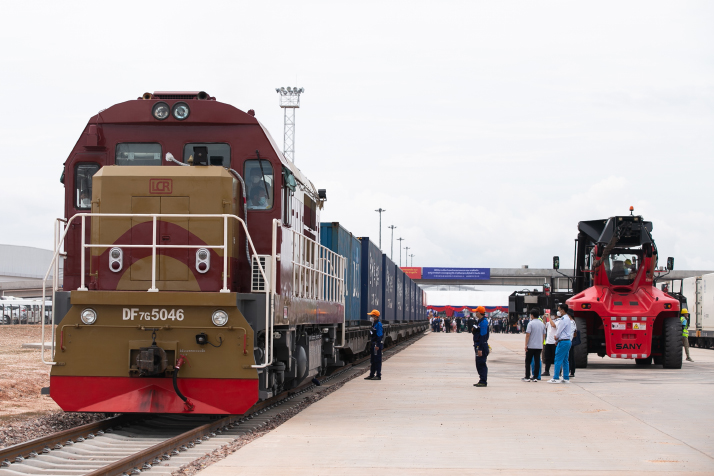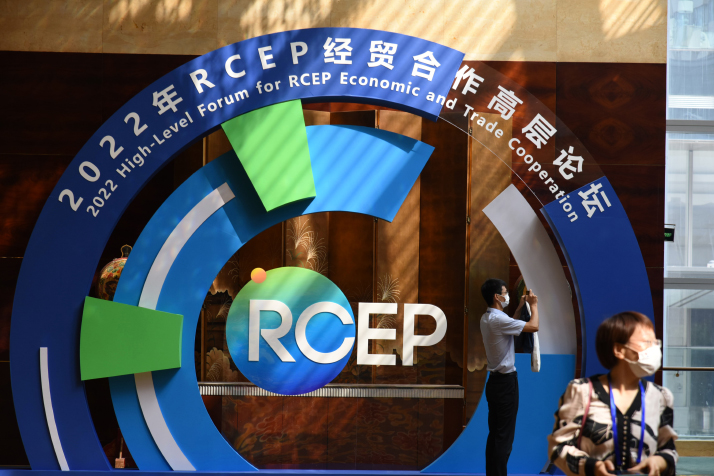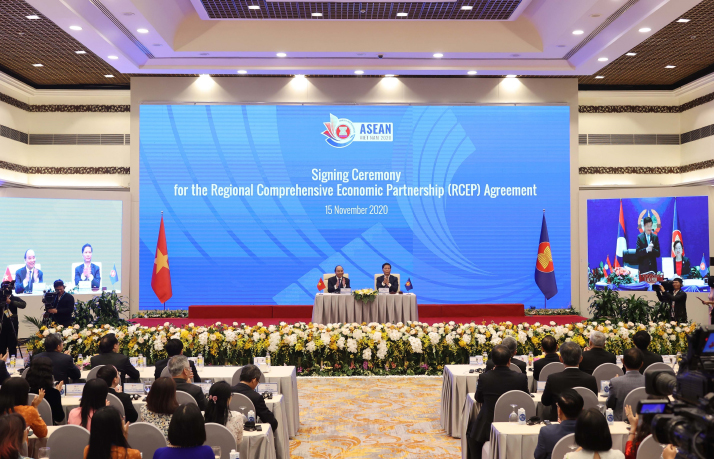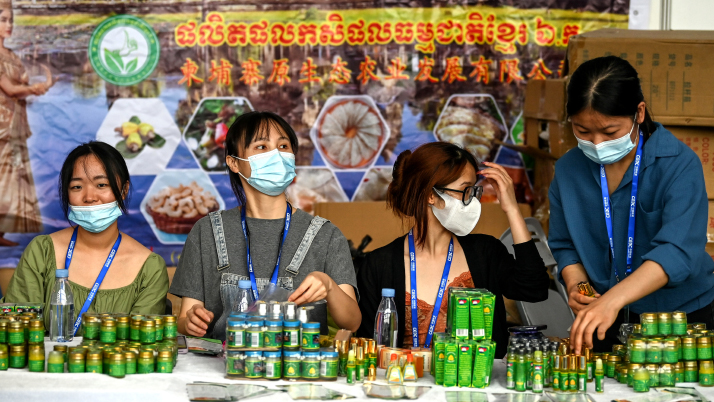| Business |
| RCEP bears remarkable fruits in first year of effectiveness | |
|
|
 Containers of Chinese exports to Thailand are reloaded at a freight transit yard of the Vientiane South Station on the China-Laos Railway on July 1, 2022 (XINHUA)
The Regional Comprehensive Economic Partnership (RCEP), consisting of 10 Association of Southeast Asian Nations (ASEAN) countries, as well as China, Japan, the Republic of Korea (ROK), Australia and New Zealand, came into force on January 1, 2022. As the world's largest free trade deal, the RCEP established a market of 2.2 billion people, or 30 percent of the world's population. Member countries combined represent roughly 30 percent of global GDP and 28 percent of international trade. One year on, the agreement has injected strong impetus into the region and the world at large. "Since its entry into force, the RCEP has borne remarkable fruits," Lu Yue, a professor at the Academy of China Open Economy Studies at the University of International Business and Economics, told Beijing Review. "It has boosted trade and economic development of its member countries and facilitated global economic recovery with a wide range of rules to promote trade and investment liberalization."  Logo of the 2022 High-Level Forum for RCEP Economic and Trade Cooperation is pictured in Qingdao, Shandong Province, on July 28, 2022. The event opened that day (XINHUA)
Growing trade China's trade with the other RCEP signatories expanded 7.9 percent year on year to 11.8 trillion yuan ($1.69 trillion) in the first 11 months of 2022, accounting for 30.7 percent of its import-export volume, according to the Ministry of Commerce. Other members have also reported an increase in foreign trade as a result of their RCEP membership. The RCEP has brought Japan and its largest trading partner China into the same free trade framework for the first time. Japan's exports of agricultural, forestry, fishery and food products hit 1.12 trillion yen ($8.34 billion) in the first 10 months last year. The Chinese mainland's imports of these items exceeded those of any other country, with total volume increasing 24.5 percent year on year, according to Japan's leading news outlet Nikkei. Official data shows that Thailand's trade with other RCEP member countries, which accounts for around 60 percent of its total foreign trade, rose 10.1 percent year on year to $252.73 billion in the first nine months of 2022. "The RCEP is also playing a significant role in driving the overall economic growth of member countries," Lu said. According to an estimate by the U.S. research organization Peterson Institute for International Economics, the pact is expected to generate a net increase of $519 billion in exports and $186 billion in national income for its members each year by 2030. "From the perspective of international trade and economic governance, the RCEP takes into account different economic development levels of its member countries and reflects the spirit of fairness, justice, inclusiveness and mutual benefit," Yu said. "It will greatly stimulate global economic progress in the post-pandemic era."  Vietnamese representatives attend the signing ceremony for the Regional Comprehensive Economic Partnership agreement via video link in Hanoi, Viet Nam (XINHUA)
Closer integration The factory of Taijixin Auto Parts Co. Ltd. needed to work at full capacity to complete its orders by the end of 2022. The company in China's eastern province of Zhejiang imports components from Japan, assembles them with China-made parts and exports the resulting automobile fittings to a factory of Japanese automaker Nissan in Thailand. Before the RCEP took effect, Chinese exporters were subject to the China-ASEAN Free Trade Agreement (FTA) when exporting goods to Thailand. Under this agreement, Taijixin's products were exempt from a 10-percent tariff on the condition that the value of the Chinese materials in the finished products accounted for at least 40 percent of the total. However, the company never applied for this exemption as fluctuations in the exchange rate between the Chinese yuan and the Japanese yen saw the value of the China-made components regularly dip below the 40-percent threshold. Nissan's factory paid the additional 10-percent import tariff. In contrast, RCEP rules allow Taijixin's products to be classed as originating in China as the non-Chinese components used come from Japan, another RCEP country. This rule of origin applies even if 100 percent of the components the Chinese company works with are sourced in other RCEP countries, and the resulting tariff cuts save its Thai customer around $120,000 per year. The lower tariffs also benefit Chinese importers. The average import tariff of parts imported from Japan and the ROK by machinery manufacturer Guangxi Liugong Machinery Co. Ltd. in Guangxi Zhuang Autonomous Region has dropped from 6 percent to 4.8 percent, according to a Xinhua News Agency report on January 2. Consumers, too, see tangible benefits. Since last year, Chinese supermarkets have seen a growing number of imported goods at much lower prices such as Southeast Asian fruits, cosmetics from Japan and the ROK, Australian healthcare products and dairy products from New Zealand. A dealer from a shopping mall in Yiwu, Zhejiang, told China Central Television that more than 80 percent of his company's imported goods, such as kitchenware, storage boxes and cleaning products, enjoy preferential tariffs under the RCEP. Taking one brand of Yukihira pans, a type of Japanese saucepan, as an example, its retail price was previously 258 yuan ($38), but the introduction of the RCEP has reduced the price to 218 yuan ($32). "Within the RCEP framework, regional trade and economic cooperation and two-way investment face momentous opportunities," Lu said. According to the RCEP, more than 90 percent of all merchandise traded among member countries will eventually be subject to zero tariffs, something that is celebrated by their business communities. The RCEP adopts the negative list approach for market access commitments on investment. Under the approach, all sectors and services will be liberalized except for those explicitly stated in the agreement. All 15 signatories have made high-level investment access commitments in five non-service sectors--manufacturing, agriculture, forestry, fishing and mining. The move has greatly improved the transparency of policies of all parties, Lu said. It is the first time that China has made commitments in the field of investment in the form of a negative list under an FTA.  Staff members of a Cambodian agricultural company prepare products for display at the RCEP zone of the China-ASEAN Expo in Nanning, Guangxi Zhuang Autonomous Region, on September 18, 2022 (XINHUA)
More to do Challenges coexist with opportunities. "Some other RCEP members have similar industrial systems and resources to China's, which will lead to competition on the supply side. The implementation of the RCEP therefore could incur a 'substitution effect' to China's export and industrial chains," Lu said, stressing that suppliers in some other RCEP member countries will become more competitive, benefiting from trade facilitation measures, and take away market share from Chinese companies. Regarding investment, Lu said many Chinese companies are still unfamiliar with RCEP rules, including those on investment liberalization, remedy measures and dispute resolution. They show insufficient awareness of going overseas as a way to optimize the allocation of their production capacities and protect their rights and interests in local markets. As a result, these companies may miss out on early opportunities, she added. Lu suggested companies gain a thorough understanding of different trade agreements based on their own import and export situations, gradually optimize their industrial and supply chain landscape and engage in deeper participation in regional economic and trade cooperation. "It's essential for Chinese companies operating abroad to take a long-term approach and report problems they encounter to the related authorities of host countries in a timely manner as to promote a better policy environment," she added. (Print Edition Title: Scaling New Heights) Copyedited by G.P. Wilson Comments to zhangshsh@cicgamericas.com |
|
||||||||||||||||||||||||||||
|
